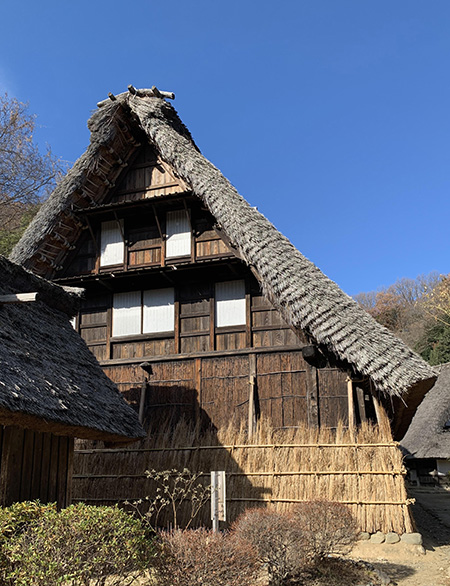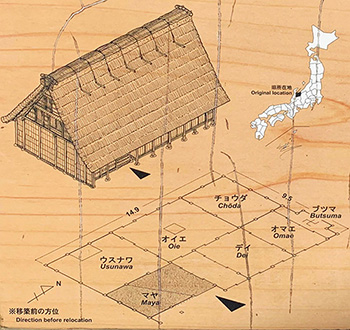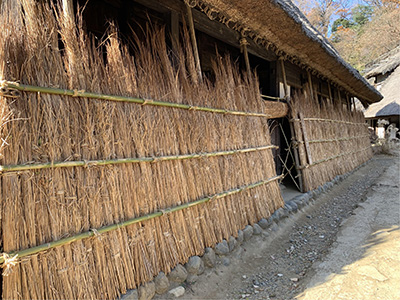

さてふたたび古民家シリーズ復帰です。
住まいと暮らしの温故知新、知れば知るほど「日本人」が見えてくる。
ということですが、人口の多い相模国から一転して富山県・五箇山。
それもいちばん岐阜県・白川郷に近い「桂」集落の住宅。
いま県境になっている「境川」をはさんで岐阜県側は加須良(かずら)で
富山県側が桂と呼ばれているそうです。
その桂地区にはかつて5軒の合掌造りがあって、
そのうちの1軒がこの「山田家住宅」ということ。
たいへんな「陸の孤島」ぶりで第2次大戦での日本の敗報が
ながくこの地には伝わらなかった、という話があるそうです。
こういう秘境でなぜ暮らしが営まれたのだろうというのが不思議。
桂集落は傾斜地のため、田はわずかしかなかった。
自給自足できるようになったのも化学肥料の普及以降というので、
畑作中心の暮らしよう。焼き畑とか、蔬菜類、養蚕なども手掛けていた。
炭焼きや狩猟も行われていたとされる。
しかし山間僻地のため出稼ぎに出た住人が正月に帰るのも難儀だったと。
冬に病人が出ると背負って山越えするしかなかった。
そういう土地柄なので火薬の材料になる「煙硝」の密かな生産が
主たる生業で加賀藩に納入されていたという説もある。
事実、床高が高くなっていて、床下で生産していた痕跡もみられる。
どうも白川郷も周辺地域とは交通も不便な立地であり
また白川郷などでは家族関係も独特の大家族制度が続いていた。
合掌造りという多雪地域対応といいきわめて多湿な「民俗性」の香り。
主たる生業も謎めいているあたり、妄想をかき立てますね。

見学時には「雪囲い」が建物をぐるっと囲んでいました。
雪国の民家では一般的ですが、茅で葺かれていかにもの地域性。
北海道も日本海側は雪国だけれど、明治以降の入植なので
「土着性」はそれほど感じられないし、
札幌への極度の人口集中など家族制度・生活文化はドライ。
彼我の違いにその根拠を探る興味が募ってきます。
<例によって連載で探究予定。続きは明日以降>
English version⬇
[Gassho-zukuri on the border between Gokayama and Shirakawa-go / Good Japanese house ㉚-1]
By the way, it is the return of the old folk house series again.
The more you know about the old and new of living and living, the more you can see the “Japanese”.
That being said, Gokayama, Toyama Prefecture, has changed from Sagami Province, which has a large population.
It is also a house in the “Katsura” village, which is the closest to Shirakawa-go, Gifu Prefecture.
The Gifu prefecture side is Kazura across the Sakai River, which is now the prefectural border.
It seems that the Toyama prefecture side is called Katsura.
There used to be 5 gassho-zukuri in the Katsura area,
One of them is this “Yamada family house”.
Japan’s defeat in World War II for the first time in a great “land island”
There is a story that it was not transmitted to this place for a long time.
I wonder why people lived in such an unexplored region.
Since the Katsura village is a slope, there were only a few rice fields.
Since it was after the spread of chemical fertilizers that it became self-sufficient,
Let’s live mainly in upland farming. He also worked on shifting cultivation, vegetables, and sericulture.
It is said that charcoal burning and hunting were also carried out.
However, it was difficult for the residents who went to work because of the remote mountainous areas to return to the New Year.
When a sick person appeared in winter, I had no choice but to carry it on my back and cross the mountain.
Because of that kind of land pattern, the secret production of “smoke glass”, which is a material for gunpowder, is
There is also a theory that it was delivered to the Kaga domain as the main business.
In fact, the floor height is high, and there are traces of production under the floor.
Apparently Shirakawa-go is also inconveniently located with the surrounding area.
In Shirakawa-go and other places, a large family system with unique family relationships continued.
It is said to be compatible with heavy snowfall areas called gassho-zukuri, and has an extremely strong scent of “folkness”.
The main business is also a mystery, so it stirs up delusions.
At the time of the tour, a “snow fence” surrounded the building.
It is common in private houses in snowy countries, but it has a thatched-roofed area.
Hokkaido is also a snowy country on the Sea of Japan side, but due to settlement after the Meiji era
I don’t really feel the “indigenous nature” of anything,
The family system and lifestyle are dry, such as the extreme concentration of population in Sapporo.
There is an interest in exploring the grounds for his difference.
Posted on 5月 11th, 2021 by 三木 奎吾
Filed under: 住宅マーケティング, 日本社会・文化研究







コメントを投稿
「※誹謗中傷や、悪意のある書き込み、営利目的などのコメントを防ぐために、投稿された全てのコメントは一時的に保留されますのでご了承ください。」
You must be logged in to post a comment.